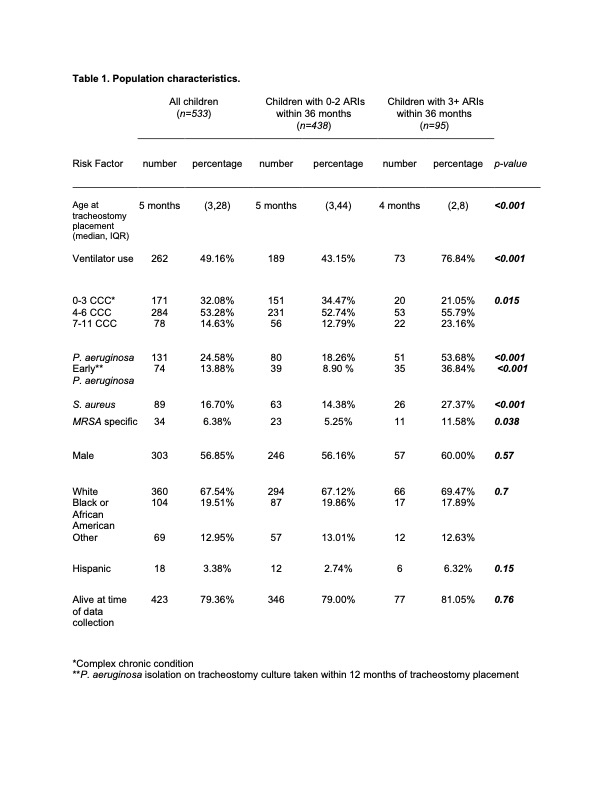Children with Chronic Conditions
Children with Chronic Conditions 3
87 - Predictors of Frequent Acute Respiratory Illnesses in Children with Tracheostomies
Publication Number: 87.305

Rebecca Steuart, MD MS (she/her/hers)
Assistant Professor of Pediatrics, Complex Care Program
Medical College of Wisconsin
Milwaukee, Wisconsin, United States
Presenting Author(s)
Background:
Children with tracheostomies are often considered high risk for contracting acute respiratory illnesses (ARIs) and receiving bacterial respiratory culture testing. It is unclear if any other factors increase a child’s likelihood of contracting more frequent ARIs.
Objective: To determine factors that contribute to a child contracting more frequent ARIs within 36 months of tracheostomy placement.
Design/Methods: This was a single center, retrospective cohort study that included children with tracheostomies placed between 2010-2018 and who had respiratory cultures obtained in the first 36 months following tracheostomy. We examined multiple demographic, clinical, and microbiologic factors. The primary outcome was the number of diagnosed ARIs within 36 months of the tracheostomy placement. Chi-square and Wilcoxon rank sum tests were used to examine differences in factors between exposure groups. Early Pseudomonas aeruginosa was further accounted for by calculating the median and IQR of time between isolation and tracheostomy placement and defined as a culture isolation within 12 months. Logistic regression equations were used to determine association of significant identified factors (ventilator use, P. aeruginosa isolation, early P. aeruginosa isolation and Staphylococcus aureus isolation) with ARI category while controlling for number of complex chronic conditions, age at tracheostomy placement, sex, race, and ethnicity.
Results: There were a total of 3,571 cultures obtained from 533 children and among these children, 95(17.82%) had 3+ ARIs(Table 1). Children with a history of ventilator use were significantly more likely to have 3+ ARIs than to have 0-2 ARIs within 36 months[76.85% vs 43.15%, p< 0.001, adjusted odds ratio (aOR) 2.9, 95% confidence interval (CI) 1.67-5.17]. The median time to first P. aeruginosa isolation was 12 months (IQR 4-32 months). Children who isolated P. aeruginosa were significantly more likely to have 3+ ARIs than to have 0-2 ARIs within 36 months(53.68% vs 18.26%, p<0.001, aOR 3.84, 95% CI 2.34-6.34); those with early P. aeruginosa were also more likely to have 3+ ARIs(aOR 3.38, 95% CI 1.97-5.81). Isolation of S. aureus on culture post tracheostomy did not lead to increased likelihood of having 3+ ARIs compared to having 0-2 ARIs within 36 months(27.37% vs 14.38%, p</span><0.001, aOR 1.44, 95% CI 0.95-2.21).
Conclusion(s): Ventilator use and P. aeruginosa isolation were associated with experiencing 3+ diagnosed ARIs within 36 months of tracheostomy placement. Future studies should examine the comparative effectiveness of culture-directed antibiotic treatments in reducing ARI frequency.
